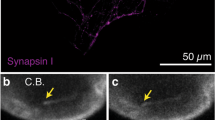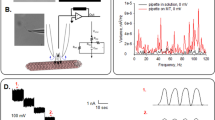Summary
Effects of the reagents suppressing or supporting axoplasmic microtubule assembly were studied on the Na ionic current of squid giant axons by perfusing the axon internally with the solution containing the reagent. Among the reagents suppressing the assembly, colchicine, vinblastine, podophyllotoxin, sulfhydryl reagents such as DTNB and NEM, and chaotropic anions such as iodide and bromide, were examined. These reagents reduced maximum Na conductance and shifted the voltage dependence of steady-state Na activation in a depolarizing direction along the voltage axis. They also made the voltage dependence less steep, but did not affect sodium inactivation appreciably. Effects on Na ionic current of reagents which support microtubule assembly (Taxol, DMSO, D2O and temperature) were opposite the effects of those agents suppressing assembly. At the same time, we demonstrated that after Na currents were partially reduced, they could be restored by internally perfusing the axon with a solution containing microtubule proteins, 260K proteins and cAMP under conditions favorable for microtubule assembly. For full restoration, it was found that the following conditions were necessary: (1) The microenvironment within the axon is suitable for microtubule assembly. (2) Tubulins incorporated into microtubules are fully tyrosinated at their C-termini. (3) A peripheral protein having a molecular weight of 260,000 daltons (260K protein) is indispensable. These results suggest that axoplasmic microtubules and 260K proteins in the structure underlying the axolemma play a role in generating Na currents in squid giant axons.
Similar content being viewed by others
References
Adelman, W., Palti, Y. 1969. The effect of external potassium and long duration voltage conditioning in the amplitude of sodium currents in the giant axon of the squidLoligo pealei.J. Gen. Physiol. 54:589–606
Armstrong, C.M., Bezanilla, F., Rojas, E. 1973. Destruction of sodium conductance inactivation in squid axons perfused with pronase.J. Gen. Physiol. 62:375–391
Baker, P.F., Hodgkin, A.L., Shaw, T.I. 1962. Replacement of the axoplasm of giant nerve fibres with artificial solutions.J. Physiol. (London) 164:330–354
Berlin, R.D., Caron, J.M., Huntley, R. 1982. New roles for tubulin membrane function.In: Biological Functions of Microtubules and Related Structures. H. Sakai, G.G. Borisy and H. Mohri, editors. pp. 405–424. Academic, Tokyo
Bezanilla, F., Armstrong, C.M. 1977. Inactivation of the sodium channel. I. Sodium current experiments.J. Gen. Physiol. 70:549–566
Bezanilla, F., Taylor, R.E. 1978. Effect of temperatur on gating currents.Biophys. J. 21:85a
Chandler, W.K., Meves, H. 1970. Slow changes in membrane permeability and long lasting action potentials in axons perfused with fluoride solutions.J. Physiol. (London) 211:707–728
Cheung, W.Y. 1970. Cyclic 3′, 5′-nucleotide phosphodiesterase. Demonstration of an activator.Biochem. Biophys. Res. Commun. 38:533–538
Conti, F., Palmieri, G. 1968. Nerve fiber behavior in heavy water under voltage-clamp.Biophysik 5:71–77
Eaton, D.C., Brodwick, M.S. 1975. Effect of internal divalent cations on squid axon.Biophys. J. 15:41a
Endo, S., Sakai, H., Matsumoto, G. 1979. Microtubules in squid giant axon.Cell Struct. Funct. 4:285–293
Gillespie, J.I., Meves, H. 1980. The time course of sodium inactivation in squid giant axons.J. Physiol. (London) 299:289–307
Himes, R.H., Burton, P.R., Kersey, R.N., Pierson, G.B. 1976. Brain tubulin polymerization in the absence of “microtubule-associated-proteins.”Proc. Natl. Acad. Sci. USA 73:4397–4399
Hodge, A.J., Adelman, W.J., Jr. 1980. The neuroplasmic network inLoligo andHermissenda neurons.J. Ultrastruct. Res. 70:220–241
Hodgkin, A.L., Huxley, A.F. 1952. A quantitative description of membrane current and its application to conduction and excitation in nerve.J. Physiol. (London) 117:500–544
Inoué, S., Sato, H. 1967. Cell motility by labile association of molecules. The nature of mitotic fibers and their role in chromosomal movement.J. Gen. Physiol. 50:259–292
Kakiuchi, S., Yamazaki, R. 1970. Calcium dependent phosphodiesterase activity and its activating factor (PAF) from brain. Studies on cyclic 3′, 5′-nucleotide phosphodiesterase (III).Biochem. Biophys. Res. Commun. 41:1104–1110
Katz, G.M., Schwartz, T.L. 1974. Temporal control of voltageclamped membranes: An examination of principles.J. Membrane Biol. 17:275–291
Kimura, J.E., Meves, H. 1979. The effect of temperature on the asymmetrical charge movement in squid giant axons.J. Physiol. (London) 289:479–500
Kobayashi, T., Matsumoto, G. 1982. Cytoplasmic tubulin from squid nerve fully retains C-terminal tyrosine.J. Biochem. 92:647–652
Kuriyama, R. 1975. Further studies on tubulin polymerizationin vitro.J. Biochem. 77:23–31
Kuriyama, R., Sakai, H. 1974. Role of tubulin-SH groups in polymerization to microtubules. Functional-SH groups in tubulin for polymerization.J. Biochem. 761:651–654
Laemmli, U.K. 1970. Cleavage of structural proteins during the assembly of the head of bacteriophage T4.Nature (London) 227:680–685
Lowry, O.H., Rosebrough, N.J., Farr, A.L., Randall, R.J. 1951. Protein measurement with the Folin phenol reagent.J. Biol. Chem. 193:265–275
Marcum, J.M., Dedman, J.R., Brinkley, B.R., Means, R.R. 1978. Control of mictotubule assembly-disassembly by calcium-dependent regulator protein.Proc. Natl. Acad. Sci. USA 75:3771–3775
Margolis, R.L., Wilson, L. 1977. Addition of colchicine-tubulin complex to microtubule ends: the mechanism of substoichiometric colchicine poisoning.Proc. Natl. Acad. Sci. USA 74:3466–3470
Matsumoto, G. 1976. Transportation and maintenance of adult squid (Doryteuthis bleekeri) for physiological studies.Biol. Bull. 150:279–285
Matsumoto, G., Ichikawa, M., Tasaki, A. 1984. Axonal microtubules necessary for generation of sodium current in squid giant axons: II. Effect of colchicine upon asymmetrical displacement current.J. Membrane Biol. 77:93–99
Matsumoto, G., Kobayashi, T., Sakai, H. 1979. Restoration of the excitability of squid giant axon by tubulin-tyrosine ligase and microtubule proteins.J. Biochem. (Tokyo) 86:1155–1158
Matsumoto, G., Murofushi, H., Endo, S., Kobayashi, T., Sakai, H. 1982a. Tyrosinated tubulin necessary for maintenance of membrane excitability in squid giant axon.In: Structure and Function of Excitable Cells. D.C. Chang, I. Tasaki and W.J. Adelman, editors. pp. 471–483. Plenum, New York
Matsumoto, G., Murofushi, H., Endo, S., Sakai, H. 1982b. Microtubules composed of tyrosinated tubulin are required for membrane excitability in squid giant axon.In: Biological Functions of Microtubules and Related Structures. H. Sakai, H. Mohri, and G.G. Borisy, editors. pp. 391–404. Academic, Tokyo
Matsumoto, G., Murofushi, H., Sakai, H. 1980. The effects of reagents affecting microtubules and microfilaments on the excitation of the squid giant axon measured by the voltage-clamp method.Biomed. Res. 1:355–358
Matsumoto, G., Sakai, H. 1979a. Microtubules inside the plasma membrane of squid giant axons and their possible physiological function.J. Membrane Biol. 50:1–14
Matsumoto, G., Sakai, H. 1979b. Restoration of membrane excitability of squid giant axons by reagents activating tyrosine-tubulin ligase.J. Membrane Biol. 50:15–22
Matsumoto, G., Shimada, J. 1980. Further improvement upon maintenance of adult squid (Doryteuthis bleekeri) in a small circular and closed-system aquarium tank.Biol. Bull. 159:319–324
Matteson, D.R., Armstrong, C.M. 1982. Evidence for a population of sleepy sodium channels in squid axon at low temperature.J. Gen. Physiol. 79:739–758
Metuzals, J., Tasaki, I. 1978. Subaxolammal filamentous network in the giant nerve fiber of the squid (Loligo pealei L.) and its possible role in excitability.J. Cell Biol. 78:597–621
Meves, H. 1974. The effect of holding potential on the asymmetry currents in squid giant axons.J. Physiol. (London) 243:847–867
Murofushi, H. 1980. Purification and characterization of tubulin-tyrosine ligase from porcine brain.J. Biochem. 87:979–984
Murofushi, H., Minami, Y., Matsumoto, G., Sakai, H. 1983. Bundling of microtubulesin vitro by a high molecular weight protein prepared from the squid axon.J. Biochem. 93:639–650
Narahashi, T., Anderson, N.C., Moore, J.W. 1967. Comparison of tetrodotoxin and procaine in internally perfused squid giant axons.J. Gen. Physiol. 50:1413–1428
Ohtsubo, K., Sakai, H., Murofushi, H., Kuriyama, R. 1975. Electrophoretic separation of tubulin and subunits after S-sulfonation.J. Biochem. 77:17–21
Olmsted, J.B., Borisy, G.G. 1975. Ionic and nucleotide requirements for microtubule polymerizationin vitro.Biochemistry 14:2996–3005
Oxford, G.S., Wu, C.H., Narahashi, T. 1978. Removal of sodium channel inactivation in squid giant axons by N-bromoacetamide.J. Gen. Physiol. 71:227–247
Pant, H.C., Shecket, G., Gainer, H., Lasek, R.J. 1978. Neurofilament protein is phosphorylated in the squid giant axon.J. Cell Biol. 78:R23-R27
Rudy, B. 1978. Slow inactivation of sodium conductance in squid giant axons. Pronase resistance.J. Physiol. (London) 283:1–21
Rudy, B. 1981. Slow inactivation of voltage-dependent channels.In: Nerve Membrane, Biochemistry and Function of Channel Proteins. G. Matsumoto and M. Kotani, editors. pp. 89–111. University of Tokyo Press, Tokyo
Runge, M.S., Schlaepfer, W.W., Williams, R.C., Jr. 1981. Isolation and characterization of neurofilaments from mammalian brain.Biochemistry 20:170–175
Sakai, H. 1980. Regulation of microtubule assemblyin vitro.Biomed. Res. 1:359–375
Sakai, H., Matsumoto, G. 1978. Tubulin and other proteins from squid giant axon.J. Biochem. 83:1413–1422
Sato, H., Takahashi, T.C., Sata, Y. 1980. Isotope effect of heavy water on spindle assembly and anaphase chromosome movement in dividing cells.Eur. J. Cell Biol. 22:310
Schauf, C.L. 1973. Temperature dependence of the ionic current kinetics ofMyxicola giant axons.J. Physiol. (London) 235:197–205
Schauf, C.L., Bullock, J.O. 1980. Solvent substitution as a probe of channel gating inMyxicola. Differential effects of D2O on some components of membrane conductance.Biophys. J. 30:295–305
Schiff, P.B., Fant, J., Horwitz, S.B. 1979. Promotion of microtubule assemblyin vitro by Taxol.Nature (London) 277:665–667
Schiff, P.B., Horwitz, S.B. 1980. Taxol stabilizes microtubules in mouse fibroflast cells.Proc. Natl. Acad. Sci. USA 77:1561–1565
Shelanski, M.L., Gaskin, F., Cantor, C.R. 1973. Microtubule assembly in the absence of added nucleotides.Proc. Natl. Acad. Sci. USA 70:765–768
Sherline, P., Leung, J.T., Kipnis, D.M. 1976. Binding of colchicine to purified microtubule protein.J. Biol. Chem. 250:5481–5486
Spudich, J.A., Watt, S. 1971. The regulation of rabbit skeletal muscle contraction. I. Biochemical studies of the interaction of the tropomyosin-troponin complex with actin and the proteolytic fragments of myosin.J. Biol. Chem. 246:4866–4871
Tasaki, I. 1968. Nerve Excitation, A Macromolecular Approach. Charles C. Thomas, Springfield, Mass.
Tasaki, I., Singer, I., Takena, T. 1965. Effects of internal and external ionic environment on excitability of squid giant axon: A macromolecular approach.J. Gen. Physiol. 48:1095–1123
Terakawa, S., Nagano, M., Watanabe, A. 1978. Intracellular pH and plateau duration of internally perfused squid giant axons.Jpn. J. Physiol. 28:847–862
Vallee, R.B. 1982. A Taxol-dependent procedure for the isolation of microtubules and microtubule-associated proteins (MAPs).J. Cell Biol. 92:435–442
Wallin, M., Larsson, H., Edstrom, A. 1977. Tubulin sulfhydryl groups and polymerizationin vitro. Effect of di- and trivalent cations.Exp. Cell Res. 107:219–225
Weber, K., Osborn, M. 1969. The reliability of molecular weight determination by dodecyl sulfate-polyacrylamide gel electrophoresis.J. Biol. Chem. 244:4406–4412
Weisenberg, R.C., Borisy, G.G., Taylor, E.W. 1968. The colchicine-binding protein of mammalian brain and its relation to microtubules.Biochemistry 7:4466–4479
Wilson, L. 1970. Properties of colchicine binding protein from chick embryo brain. Interactions with vinca alkaloids and podophyllotoxin.Biochemistry 9:4999–5007
Wilson, L., Bamburg, J.R., Mizel, S.B., Grisham, L.M., Creswell, K.M. 1974. Interaction of drugs with microtubule proteins.Fed. Proc. 33:158–166
Zackroff, R.V., Goldman, R.D. 1980.In vitro reassembly of squid brain intermediate filaments (neurofilaments): Purification by assembly-disassembly.Science 208:1152–1155
Author information
Authors and Affiliations
Rights and permissions
About this article
Cite this article
Matsumoto, G., Ichikawa, M., Tasaki, A. et al. Axonal microtubules necessary for generation of sodium current in squid giant axons: I. pharmacological study on sodium current and restoration of sodium current by microtubule proteins and 260K protein. J. Membrain Biol. 77, 77–91 (1983). https://doi.org/10.1007/BF01925858
Received:
Revised:
Issue Date:
DOI: https://doi.org/10.1007/BF01925858




